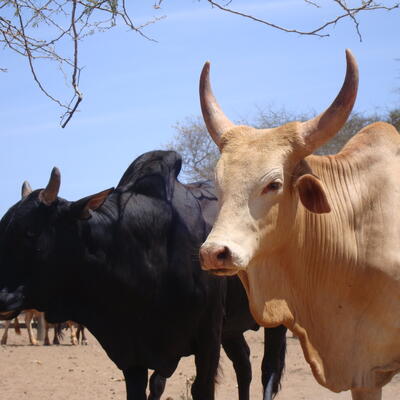

Ukama Ustawi: Enhancing drought resilience using legumes in maize systems
In large parts of sub-humid Africa including Zimbabwe, maize is the main source of livelihood for smallholder farmers who often consider it as a staple and cash crop.
However, the constant threats of climate-change induced droughts reduce production of maize. This decreases food security and livelihoods for the farmers who are dependent on such cereal crops.
In the face of increasing climate change-induced droughts, ILRI, through the CGIAR’s Ukama Ustawi Initiative is creating innovative strategies to safeguard livelihoods by empowering smallholder farmers in Zimbabwe to intensify, diversify and de-risk maize-mixed farming through the integration of legume crops into traditional maize-cropping systems. This method not only enhances soil fertility and moisture retention but also provides a diversified and resilient agricultural system. The forage legumes are used to formulate supplementary feeds for their livestock.
Legumes, such as beans and peas, are known for their ability to fix atmospheric nitrogen into the soil. This natural fertilization process reduces the need for synthetic fertilizers and improves soil structure, allowing for better water retention during dry periods. By introducing legumes into maize fields, farmers create a more diversified cropping system. This diversity can reduce the risk of total crop failure during droughts, as legumes often have different water requirements and growth patterns compared to maize.

The integration of legumes also benefits livestock. Legume crops can serve as an additional feed source, offering high-protein forage that supports animal health and productivity. This becomes particularly valuable during droughts when traditional forage might be scarce. By diversifying their feed sources through legume cultivation, farmers can better withstand periods of drought. The availability of alternative, drought-resistant forage ensures that livestock have a consistent food supply, reducing the overall impact of drought on farming operations.
‘We are introducing ways of feeding livestock using forage legumes, maize grain and stover produced from the maize-based farming system. The goal is for the farmer to either sustain his livestock through the dry season thus creating resilience to the drought or even for sale to generate income,’ said Godfrey Manyawu, an ILRI forage scientist.
In this practice, residues from the legumes such as Velvet bean, groundnut haulms and Lablab-bean are used to create feed rations incorporating maize grain and fed to livestock during the dry season, which is normally experienced from June to December.
This intensification of maize-based mixed-farming systems and subsequent feed formulation has proved a reliable climate change risk mitigation strategy for farmers.
‘I started rearing goats in 2022 but due to lack of adequate feed my goats were not reproducing. However, when I joined the Ukama Ustawi initiative I was equipped with knowledge on cultivating forage legumes and how to mix them with maize products to produce livestock feed. I now find goat rearing less difficult because of the knowledge I acquired on good animal husbandry practices. My goats have not only increased in numbers from 7 to 16, their health and market value has also improved. I am expecting kids from at least 8 goats in the next three months,’ said William Nyamusanduka, a Boer goat farmer from Ward 6, Shamva District.
Eronika Chikuruwo from Murehwa recently sold her 282-kg steer following a weight gain of 32kg in one month after feeding with maize and forage legumes. She said she now understands the importance of value addition in maize-based mixed farming systems. She added that before joining the Ukama Ustawi Initiative she would sell all her maize soon after harvest to raise income. She would also sell-off emaciated cattle at the end of the dry season to salvage some economic value, as a mitigation against poverty deaths.

You may also like

ILRI News
ILRI supports Sierra Leone's livestock sector with high-yield forage seeds, boosting food security

ILRI News
Cultivated forages boost production and income for dairy farmers in Bishoftu District, Ethiopia
ILRI News
Tanzania launches Africa Accelerated Innovation Delivery Initiative-Livestock project to boost poultry productivity
ILRI News
Using gendered assessment to promote sustainable livestock feed management in Dodoma, Tanzania
Related Publications

Effect of variation in gridded cattle diet composition on estimated enteric methane emissions in data sparse tropical regions
- Mutua, John Y.
- Duncan, Alan J.
- Robinson, Timothy P.
- Fraval, Simon
- Notenbaert, An Maria Omer
- Watmough, Gary R.

Effect of plant-derived feed additives on enteric methane emission, nutrient digestibility and immune status of adult male goats
- Kumari, N.
- Kala, A.
- Agarwal, N.
- Chaturvedi, V.B.
- Kennady, Vijayalakshmy
- Chaudhary, L.C.

Ubushikiranganji bw’ibidukikije, uburimyi n’ubworozi: ifishi y’ubuhinga bwo kubika ubwatsi ubuvunditse (ensilage)
- International Livestock Research Institute
- International Institute of Tropical Agriculture

Gender dynamics in feed and forage production and utilization in Mpigi District, Uganda
- Njiru, Nelly
- Njuguna-Mungai, Esther
- Namatovu, Jane
- Terfa, Zelalem
- Galiè, Alessandra
- Businge, Martha
- Maina, Kevin
- Ahumuza, Ronnie
- Lukuyu, Ben A.










